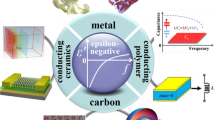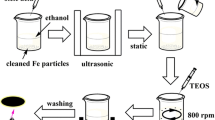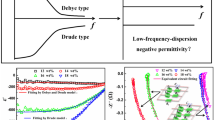Abstract
Metamaterials with metal conductive phase always suffer from their high negative permittivity (epsilon-negative), the mechanism of negative permittivity is still need to be explored. Herein, we prepared iron (Fe)/epoxy composites by mechanical mixing and pressure forming. With the increase of Fe content, the conductive behavior changed from hopping conduction to metal-like conduction. The permittivity became negative when the iron content exceeded the percolation threshold (0.425), the negative permittivity was caused by the plasma oscillation of delocalized electrons in the iron conductive network. Besides, when the iron content was 50, 55, 60 or 70 vol%, the permittivity changed from negative to positive at certain frequency points, which is called epsilon-near-zero property. We used the Debye-Drude model to analyze this special dielectric behavior, and the fitting results are in good agreement with the experimental results. A transformation from capacitive to inductive was founded by using equivalent circuit analysis model, this suggests that the occurrence of negative permittivity is accompanied by the appearance of inductance and the negative permittivity behavior is inductance. The epsilon-near-zero and epsilon-negative property could be adjusted effectively by simply changing iron content. Our work provides an understanding guidance on the mechanism of epsilon-negative and epsilon-near-zero property and offers an efficient way to regulate the dielectric property.




Similar content being viewed by others
References
J. Valentine, S. Zhang, T. Zentgraf, E. Ulin-Avila, D. Genov, G. Bartal, X. Zhang, Three-dimensional optical metamaterial with a negative refractive index. Nature 455, 376–379 (2008)
S. Lee, C. Park, Y. Seo, C. Kim, Reversed Doppler effect in double negative metamaterials. Phys. Rev. B 81, 241102 (2010)
S. Linden, C. Enkrich, M. Wegener, J. Zhou, T. Koschny, C. Soukoulis, Magnetic response of metamaterials at 100 terahertz. Science 306, 1351–1353 (2004)
W. Padilla, D. Basov, D. Smith, Negative refractive index metamaterials. Mater. Today 9, 28–35 (2006)
A. Houck, J. Brock, I. Chuang, Experimental observations of a left-handed material that obeys Snell’s Law. Phys. Rev. Lett. 90, 137401 (2003)
A. Zharov, I. Shadrivov, Y. Kivshar, Nonlinear properties of left-handed metamaterials. Phys. Rev. Lett. 91, 037401 (2003)
A. Cho, Voila! cloak of invisibility unveiled. Science 314, 403 (2006)
T. Ergin, N. Stenger, P. Brenner, J. Pendry, M. Wegener, Three-dimensional invisibility cloak at optical wavelengths. Science 328, 337–339 (2010)
N. Landy, S. Sajuyigbe, J. Mock, D. Smith, W. Padilla, Perfect metamaterial absorber. Phys. Rev. Lett. 100, 207402 (2008)
W. Li, U. Guler, N. Kinsey, G. Naik, A. Boltasseva, J. Guan, V. Shalaev, A. Kildishev, Plasmonics: refractory plasmonics with titanium nitride: broadband metamaterial absorber. Adv. Mater. 26, 7921–7921 (2014)
B. Edwards, A. Alù, M. Young, M. Silveirinha, N. Engheta, Experimental verification of epsilon-near-zero metamaterial coupling and energy squeezing using a microwave waveguide. Phys. Rev. Lett. 100, 033903 (2008)
N. Engheta, Pursuing near-zero response. Science 340, 286–287 (2013)
N. Wu, X. Bai, B. Dong, R. Wei, N. Naik, R. Patil, Z. Guo, Recent advances of asymmetric supercapacitors. Adv. Mater. Interfaces 8, 2001710 (2020)
H. Chen, Metamaterials: constitutive parameters, performance, and chemical methods for realization. J. Mater. Chem. 21, 6452–6463 (2011)
Y. Huang, Z. Yao, F. Hu, C. Liu, L. Yu, Y. Jin, X. Xu, Tunable circular polarization conversion and asymmetric transmission of planar chiral graphene-metamaterial in terahertz region. Carbon 119, 305–313 (2017)
J. Pendry, A. Holden, W. Stewart, I. Youngs, Extremely low frequency plasmons in metallic mesostructures. Phys. Rev. Lett. 76, 4773–4776 (1996)
J. Pendry, A. Holden, D. Robbins, W. Stewart, Magnetism from conductors and enhanced nonlinear phenomena. IEEE Trans. Microw. Theor. Technol. 47, 2075–2084 (1999)
J. Gao, X. Wu, Q. Li, S. Du, F. Huang, L. Liang, H. Zhang, F. Zhuge, H. Cao, Y. Song, Template-free growth of well-ordered silver nano forest/ceramic metamaterial films with tunable optical responses. Adv. Mater. 29, 1605324 (2017)
Z. Shi, R. Fan, Z. Zhang, L. Qian, M. Gao, M. Zhang, L. Zheng, X. Zhang, L. Yin, Random composites of nickel networks supported by porous alumina toward double negative materials. Adv. Mater. 24, 2349–2352 (2012)
B. Li, G. Sui, W. Zhong, Single negative metamaterials in unstructured polymer nanocomposites toward selectable and controllable negative permittivity. Adv. Mater. 21, 4176–4180 (2009)
C. Cheng, R. Fan, Z. Wang, Q. Shao, X. Guo, P. Xie, Y. Yin, Y. Zhang, L. An, Y. Lei, J. Ryu, A. Shankar, Z. Guo, Tunable and weakly negative permittivity in carbon/silicon nitride composites with different carbonizing temperatures. Carbon 125, 103–112 (2017)
Y. Jiang, P. Xie, Z. Wang, G. Fan, Y. Qu, K. Sun, H. Man, Z. Zhang, Y. Liu, R. Fan, Iron granular percolative composites toward radio-frequency negative permittivity. ECS J. Solid State Sci. Technol. 7, N132–N136 (2018)
K. Sun, R. Fan, Z. Zhang, K. Yan, X. Zhang, P. Xie, M. Yu, S. Pan, The tunable negative permittivity and negative permeability of percolative Fe/Al2O3 composites in radio frequency range. J. Mater. Chem. C 106, 172902 (2015)
T. Tsutaoka, T. Kasagi, S. Yamamoto, K. Hatakeyama, Low frequency plasmonic state and negative permittivity spectra of coagulated Cu granular composite materials in the percolation threshold. Appl. Phys. Lett. 102, 181904 (2013)
X. Wang, Z. Shi, M. Chen, R. Fan, K. Yan, K. Sun, S. Pan, M. Yu, Tunable electromagnetic properties in Co/Al2O3 cermets prepared by wet chemical method. J. Am. Ceram. Soc. 97, 3223–3229 (2014)
Z. Wang, P. Xie, G. Fan, Z. Zhang, Y. Liu, Q. Gu, R. Fan, Epsilon-negative behavior of BaTiO3/Ag metacomposites prepared by an in situ synthesis. Ceram. Int. 46, 9342–9346 (2020)
P. Xie, Y. Li, Q. Hou, K. Sui, C. Liu, X. Fu, J. Zhang, V. Murugadoss, J. Fan, Y. Wang, R. Fan, Z. Guo, Tunneling-induced negative permittivity in Ni/MnO nanocomposites by a bio-gel derived strategy. J. Mater. Chem. C 8, 3029–3039 (2020)
H. Luo, J. Qiu, Carbon nanotubes / epoxy resin metacomposites with adjustable radio-frequency negative permittivity and low dielectric loss. Ceram. Int. 45, 843–848 (2019)
Y. Zhou, P. Wang, G. Ruan, P. Xu, Y. Ding, Synergistic effect of P[MPEGMA-IL] modified graphene on morphology and dielectric properties of PLA/PCL blends. ES Mater. Manuf. 11, 20–29 (2021)
P. Xie, Z. Wang, Z. Zhang, R. Fan, C. Cheng, H. Liu, Y. Liu, T. Li, C. Yan, N. Wang, Z. Guo, Silica microsphere templated self-assembly of a three-dimensional carbon network with stable radio-frequency negative permittivity and low dielectric loss. J. Mater. Chem. C 6, 5239–5249 (2018)
T. Haldar, U. Kumar, B. Yadav, V. Kumar, Tunable negative permittivity of Bi2O3–SiO2/MWCNT glass-nanocomposites at radio frequency region. J. Mater. Sci. Mater. Electron. 31, 11791–11800 (2020)
C. Hou, G. Fan, X. Xie, X. Zhang, X. Sun, Y. Zhang, B. Wang, W. Du, R. Fan, TiN/Al2O3 binary ceramics for negative permittivity metacomposites at kHz frequencies. J. Alloys Compd. 855, 157499 (2021)
Y. Qu, G. Fan, D. Liu, Y. Gao, C. Xu, J. Zhong, P. Xie, Y. Liu, Y. Wu, R. Fan, Functional nano-units prepared by electrostatic self-assembly for three-dimension carbon networks hosted in CaCu3Ti4O12 ceramics towards radio-frequency negative permittivity. J. Alloys Compd. 743, 618–625 (2018)
Q. Hou, K. Yan, R. Fan, Z. Zhang, M. Chen, K. Sun, C. Cheng, Experimental realization of tunable negative permittivity in percolative Fe78Si9B13/epoxy composites. RSC Adv. 5, 9472–9475 (2015)
K. Sun, Z. Wang, J. Xin, Z. Wang, P. Xie, G. Fan, V. Murugadoss, R. Fan, J. Fan, Z. Guo, Hydrosoluble graphene/polyvinyl alcohol membranous composites with negative permittivity behavior. Macromol. Mater. Eng. 305, 1900709 (2020)
Z. Wang, P. Xie, C. Cheng, G. Fan, Z. Zhang, R. Fan, X. Yin, Regulation mechanism of negative permittivity in poly(p-phenylene sulfide)/multiwall carbon nanotubes composites. Synth. Met. 244, 15–19 (2018)
E. Dai, G. Li, G. Lu, W. Wang, Z. Han, Z. Song, Q. Zhang, H. Yuan, X. Zhang, Tribological behavior and wear mechanism of Cu/CF/phenolic resin sandwich composites under current. J. Ind. Text. (2020). https://doi.org/10.1177/1528083720966697
Z. Shi, R. Fan, K. Yan, K. Sun, M. Zhang, C. Wang, X. Liu, X. Zhang, Preparation of iron networks hosted in porous alumina with tunable negative permittivity and permeability. Adv. Funct. Mater. 23, 4123–4132 (2013)
Y. Liu, C. Xu, H. Ren, Z. Wei, Z. Zhang, Tailorable negative permittivity in Fe/BaTiO3 meta-composites. Funct. Mater. Lett. 13, 2050017 (2020)
M.V. Singh, Conversions of waste tube-tyres (WTT) and waste polypropylene (WPP) into diesel fuel through catalytic pyrolysis using base SrCO3. Eng. Sci. 13, 87–97 (2021)
W. Zou, J. Huang, W. Zeng, X. Lu, Effect of ethylene-butylacrylate-glycidyl methacrylate on compatibility properties of poly (butylene terephthalate)/ thermoplastic polyurethane blends. ES Energy Environ. 9, 67–73 (2020)
L. Mu, Y. Dong, L. Li, X. Gu, Y. Shi, Achieving high value utilization of bio-oil from lignin targeting for advanced lubrication. ES Mater. Manuf. 11, 72–80 (2021)
J. Li, P. Zhang, H. He, S. Zhai, Y. Xian, W. Ma, L. Wang, Enhanced thermal transport properties of epoxy resin thermal interface materials. ES Energy Environ. 4, 41–47 (2019)
K. Shi, Y. Shen, Y. Zhang, T. Wang, A modified imidazole as a novel latent curing agent with toughening effect for epoxy. Eng. Sci. 5, 66–72 (2019)
X. Jing, J. Wei, Y. Liu, B. Song, Y. Liu, Deployment analysis of aramid fiber reinforced shape-memory epoxy resin composites. Eng. Sci. 11, 44–53 (2020)
P. Feng, L. Ma, G. Wu, X. Li, M. Zhao, L. Shi, M. Wang, X. Wang, G. Song, Establishment of multistage gradient modulus intermediate layer between fiber and matrix via designing double “rigid-flexible” structure to improve interfacial and mechanical properties of carbon fiber/resin composites. Compos. Sci. Technol. 200, 108336 (2020)
Y. He, Q. Chen, S. Yang, C. Lu, M. Feng, Y. Jiang, G. Cao, J. Zhang, C. Liu, Micro-crack behavior of carbon fiber reinforced Fe3O4/graphene oxide modified epoxy composites for cryogenic application. Compos. Part A 108, 12–22 (2018)
D. Pan, Q. Li, W. Zhang, J. Dong, F. Su, V. Murugadoss, Y. Liu, C. Liu, N. Naik, Z. Guo, Highly thermal conductive epoxy nanocomposites filled with 3D BN/C spatial network prepared by salt template assisted method. Compos. B 209, 108609 (2021)
L. Shi, G. Song, P. Li, X. Li, D. Pan, Y. Huang, L. Ma, Z. Guo, Enhancing interfacial performance of epoxy resin composites via in-situ nucleophilic addition polymerization modification of carbon fibers with hyperbranched polyimidazole. Compos. Sci. Technol. 201, 108522 (2021)
J. Ni, R. Zhan, J. Qiu, Constructing honeycomb conductive rings in graphene foam/epoxy resin metacomposites for adjustable negative permittivity, low dielectric loss tangent and mechanical enhancement. Org. Electron. 82, 105706 (2020)
Q. Jiang, Y. Lei, P. Xie, K. Sun, X. Li, S. Qu, Q. Hou, R. Fan, Reverse design of negative permittivity property in nickel-network/epoxy composites. Mater. Lett. 248, 177–180 (2019)
C. Cheng, R. Fan, Y. Ren, T. Ding, L. Qian, J. Guo, X. Li, L. An, Y. Lei, Y. Yin, Z. Guo, Radio frequency negative permittivity in random carbon nanotubes/alumina nanocomposites. Nanoscale 9, 5779–5787 (2017)
P. Xie, Z. Wang, K. Sun, C. Cheng, Y. Liu, R. Fan, Regulation mechanism of negative permittivity in percolating composites via building blocks. Appl. Phys. Lett. 111, 112903 (2017)
P. Xie, Z. Zhang, Z. Wang, K. Sun, R. Fan, Targeted double negative properties in silver/silica random metamaterials by precise control of microstructures. Research 2019, 1–11 (2019)
H. Gu, J. Guo, M. Khan, D. Young, T. Shen, S. Wei, Z. Guo, Magnetoresistive polyaniline–silicon carbide metacomposites: plasma frequency determination and high magnetic field sensitivity. Phys. Chem. Chem. Phys. 18, 19536–19543 (2016)
C. Nan, Y. Shen, J. Ma, Physical properties of composites near percolation. Annu. Rev. Mater. Sci. 40, 131–151 (2010)
H. Wu, Z. Mu, G. Qi, Y. Zhang, X. Wang, P. Xie, N. Wu, H. Yuan, K. Sui, R. Fan, C. Liu, Negative permittivity behavior in Ti3AlC2-polyimide composites and the regulation mechanism. J. Mater. Sci. Mater. Electron. (2021). https://doi.org/10.1007/s10854-021-05695-y
Z. Shi, S. Chen, R. Fan, X. Wang, X. Wang, Z. Zhang, K. Sun, Ultra low percolation threshold and significantly enhanced permittivity in porous metal–ceramic composites. J. Mater. Chem. C 2, 6752–6757 (2014)
Z. Shi, R. Fan, Z. Zhang, H. Gong, J. Ouyang, Y. Bai, X. Zhang, L. Yin, Experimental and theoretical investigation on the high frequency dielectric properties of Ag/Al2O3 composites. Appl. Phys. Lett. 99, 032903 (2011)
Z. Shi, R. Fan, X. Wang, Z. Zhang, L. Qian, L. Yin, Y. Bai, Radio-frequency permeability and permittivity spectra of copper/yttrium iron garnet cermet prepared at low temperatures. J. Eur. Ceram. Soc. 35, 1219–1225 (2015)
P. Mantas, Dielectric response of materials: extension to the Debye model. J. Eur. Ceram. Soc. 19, 2079–2086 (1999)
K. Sun, R. Fan, Z. Zhang, K. Yan, X. Zhang, P. Xie, M. Yu, S. Pan, The tunable negative permittivity and negative permeability of percolative Fe/Al2O3 composites in radio frequency range. Appl. Phys. Lett. 106, 172902 (2015)
K. Lee, S. Cho, S. Heum-Park, A. Heeger, C. Lee, S. Lee, Metallic transport in polyaniline. Nature 441, 65–68 (2006)
P. Xie, H. Li, B. He, F. Dang, J. Lin, R. Fan, C. Hou, H. Liu, J. Zhang, Y. Ma, Z. Guo, Bio-gel derived nickel/carbon nanocomposites with enhanced microwave absorption. J. Mater. Chem. C 6, 8812–8822 (2018)
P. Xie, Y. Liu, M. Feng, M. Niu, C. Liu, N. Wu, K. Sui, R.R. Patil, D. Pan, Z. Guo, R. Fan, Hierarchically porous Co/C nanocomposites for ultralight high-performance microwave absorption. Adv. Compos. Hybrid Mater. 4, 173–185 (2021)
Y. Zhao, Z. Yang, W. Fan, Y. Wang, G. Li, H. Cong, H. Yuan, Carbon nanotube/carbon fiber electrodes via chemical vapor deposition for simultaneous determination of ascorbic acid, dopamine and uric acid. Arab. J. Chem. 13, 3266–3275 (2020)
J. Zeng, P. Qi, Y. Wang, Y. Liu, K. Sui, Electrostatic assembly construction of polysaccharide functionalized hybrid membrane for enhanced antimony removal. J. Hazard. Mater. 410, 124633 (2021)
C. Hou, W. Yang, X. Xie, X. Sun, J. Wang, N. Naik, D. Pan, X. Mai, Z. Guo, F. Dang, W. Du, Agaric-like anodes of porous carbon decorated with MoO2 nanoparticles for stable ultralong cycling lifespan and high-rate lithium/sodium storage. J. Colloid Interface Sci. 596, 396–407 (2021)
Y. Zhou, S. Wu, Y. Ma, H. Zhang, X. Zeng, F. Wu, F. Liu, J.E. Ryu, Z. Guo, Recent advances in organic/composite phase change materials for energy storage. ES Energy Environ. 9, 28–40 (2020)
G. Liu, G. Yao, J. Xu, X. Yan, Spatial decoupling of light absorption and scattering centers in plasmon-assisted bubble column evaporator for solar steam generation. ES Energy Environ. 9, 41–49 (2020)
W. Fan, C. Shan, H. Guo, J. Sang, R. Wang, R. Zheng, K. Sui, Z. Nie, Dual-gradient enabled ultrafast biomimetic snapping of hydrogel materials. Sci. Adv. 5, 7174 (2019)
H. Wang, C. Zhang, Z. Zhang, B. Zhou, J. Shen, A. Du, Biomimetic ultra-black sponge derived from Loofah and Co-MOF for long-term solar-powered vapor generation and desalination. Sol. RRL 33, 2000817 (2021)
X. Lv, Y. Tang, Q. Tian, Y. Wang, T. Ding, Ultra-stretchable membrane with high electrical and thermal conductivity via electrospinning and in-situ nanosilver deposition. Compos. Sci. Technol. 200, 108414 (2020)
N. Wu, Q. Hu, R. Wei, X. Mai, N. Naik, D. Pan, Z. Guo, Z. Shi, Review on the electromagnetic interference shielding properties of carbon based materials and their novel composites: recent progress, challenges and prospects. Carbon 176, 88–105 (2021)
X. Ji, H. Wang, T. Chen, T. Zhang, J. Chu, A. Du, Intrinsic negative TCR of superblack carbon aerogel films and their ultrabroad band response from UV to microwave. Carbon 161, 590–598 (2020)
Y. Xi, Y. Bin, C. Chiang, M. Matsuo, Dielectric effects on positive temperature coefficient composites of polyethylene and short carbon fibers. Carbon 45, 1302–1309 (2007)
P. Xie, W. Sun, A. Du, Q. Hou, G. Wu, R. Fan, Epsilon-negative carbon aerogels with state transition from dielectric to degenerate semiconductor. Adv. Electron. Mater. 7, 2000877 (2021)
Acknowledgements
We appreciate the financial support from Key Research and Development Project of Shandong Province [Grant No. 2019GSF109079], Natural Science Foundation of Shandong Province [ZR2020QE006], Postdoctoral Applied Research Project of Qingdao, the China Postdoctoral Science Foundation [2020M671992], Postdoctoral Innovation Project of Shandong Province [202003031], the National Natural Science Foundation of China [Grant No. 52072193], and support by State Key Laboratory of Bio-Fibers and Eco-Textiles (Qingdao University).
Author information
Authors and Affiliations
Contributions
All authors contributed to the study conception and design. Material preparation, data collection, and analysis were performed by ML and PX. ML wrote the manuscript. CL, HY, KS gave the meaningful advice in theoretical analysis and wrote the manuscript. PX, CL, HY and RF gave financial support and measurement support for this work. All authors read and approved the final manuscript.
Corresponding authors
Ethics declarations
Conflict of interest
The authors declare that they have no conflict of interest.
Additional information
Publisher's Note
Springer Nature remains neutral with regard to jurisdictional claims in published maps and institutional affiliations.
Rights and permissions
About this article
Cite this article
Liu, M., Lan, X., Zhang, H. et al. Iron/epoxy random metamaterials with adjustable epsilon-near-zero and epsilon-negative property. J Mater Sci: Mater Electron 32, 15995–16007 (2021). https://doi.org/10.1007/s10854-021-06150-8
Received:
Accepted:
Published:
Issue Date:
DOI: https://doi.org/10.1007/s10854-021-06150-8




